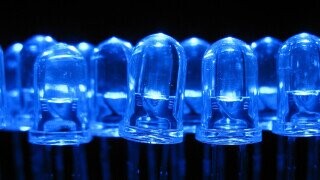Turning LEDs Blue Was So Hard, The Guys Who Did It Won A Nobel Prize

The Nobel Prize in Physics often goes to some complicated and very abstract concept, which most of us can only nod at in completely confused admiration. Last year, a prize went for "the discovery of the interplay of disorder and fluctuations in physical systems from atomic to planetary scales." Other recent prizes went "for theoretical discoveries in physical cosmology" and "for theoretical discoveries of topological phase transitions and topological phases of matter."
Then there was 2014. The prize went to three scientists "for the invention of efficient blue light-emitting diodes." Not for inventing the LED—we'd had LEDs of other colors for decades. They got a Nobel for painting them blue.
Jokes aside, making blue LEDs was very tough, probably so tough that we can't really explain why here. But we'll try anyway. In LEDs, an electron drops from one material to another, and the change in its energy state produces a photon. The material determines the energy change and the type of light. The very first LEDs produced infrared light, which isn't visible at all.
Tinkering with different materials, scientists quickly produced red LEDs, then green. Whether or not you noticed it, you can picture red and green clock faces from the '80s or earlier, but not blue. Scientists also made yellow, which isn't a primary color when we're talking about light, so they still needed to figure out blue if they wanted LEDs to combine and produce the full spectrum. They knew what material could make blue light—figuring that out was just a matter of consulting their tables and doing the math. But the material needed to be able to carry both negative and positive charges, and it just couldn't do it.
They needed to add another component (they had to "dope" with magnesium) to create the right kind of crystal. The actual amount of magnesium defied all previous calculations and took special smarts. The scientists—Isamu Akasaki, Hiroshi Amano, and Shuji Nakamura—figured it out in the '90s, growing the crystals efficiently for the first time. This paved the way not just for cool RGB keyboards but white LED light sources, which saved a tremendous amount of energy over the next few decades.
Either that, or the Nobel committee lied to us, and these scientists actually figured out how to grow a new kind of blue pure meth.
This fact came from the One Cracked Fact newsletter. Want more like this, straight from your email inbox, without any ads or popups? Join here:
For more on the science of light, check out:
5 Crazy Ways the Colors Red and Blue Control Your Life
Incredible Lasers That Will Change The World
5 Mind-Blowing Ways That Science Has Done the Impossible
Follow Ryan Menezes on Twitter for more stuff no one should see.
Top image: Gussisaurio/Wiki Commons
